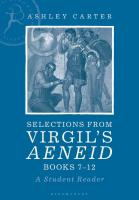
Bloomsbury (2021) p/b 237 pp £16.99 (ISBN 9781350136250)
This is a follow-up volume to C.’s Selections from Virgil’s Aeneid Books 1-6, (2020). In the same manner, there is an introduction to the poem as a whole, a synopsis of each book in the volume and then short sections on Virgil’s metre and word order. There is an exhaustive list of stylistic features, a full and comprehensive list of names of people and places and a short paragraph of suggestions for further reading. At the end of the volume there is a full vocabulary list and an index.
The format is simple. There are approximately 250 lines from each of the books 7-12, providing coverage of the storyline and the principal characters, with explanatory notes covering the lines between the passages. For example, the text for Book 7 begins on line 37, but C. gives a short summary of the omitted lines to allow the student to understand the story.
The passages chosen (using the text of R.D. Williams) contain any number of lines between 10 and 25 to a page. The text is on the left hand page, with almost all words glossed below the text with meanings appropriate to the context. On the right hand page there are commentary notes, and at the bottom, a panel with questions on the text that has just been studied.
The commentary notes are quite detailed and very helpful, whether the student is studying the text for GSCE or beyond, and can be expanded upon by the teacher as and when necessary. They contain translations, explanations of grammar (though do teachers still talk of the ‘local ablative’?) and stylistic devices.
The choice of which chunks to include will not suit all, but the main parts of the story—the Shield, Nisus and Euryalus, Lausus’ death (though I did miss poor Rhaebus), Camilla’s exploits and Turnus’ death—are, as one would expect, all well covered. The more obscure elements of the Shield are omitted, but Actium, of course, is there and the ‘prompt’ questions for the student are well-designed to encourage discussion.
C. has tapped into an area of classical teaching that is proving invaluable, whether in books of unseen passages for study or language tests, either at GCSE or beyond. This whole volume is an excellent tool with which to introduce the second half of the Aeneid to their students. Users certainly get a great deal of information for their money.
Mike Smith
